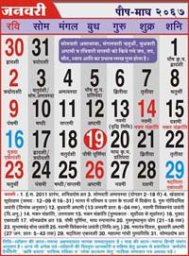- Astrology for Old People
- Astrology for Man/Woman
- Astrology for Marriage
- Astrology for Love
- Astrology for Student
- Astrology for Career/Job
- Astrology for Business
- Astrology for Money
- Astrology for Health
- Astrology for Child
- Astrology for Peace & Harmony
2011 Hindu Calenders
29 December 2010- Hindu calender is also known as "Penchang" or "panchanga" or "Panjika". It is very helpful in calculating the dates of festivals, full moon and no moon night and other such events that are important in Hindu religion. For calculating the dates, movement of moon are considered. Vedanga Jyotisha of Lagadha of late BCE subsidiary to the Vedas is the root of almost all the Hindu calender in India. Hindu calender is based on the astronomical calculations.
Parts of Hindu Calender- Tithi
- Vaara (day)
- Nakshatra
- Karana
- Yoga
Vaara in Hindu Calender

Soma Vaara = Monday Soma = Moon
Mangala Vaara = Tuesday Mangala = Mars
Budha Vaara = Wednesday Budha = Mercury
Guru Vaara = Thursday Guru (Brihaspati) = Jupiter
Shukra Vaara = Friday Shukra = Venus
Shani Vaara = Saturday Shani = Saturn Types of Hindu CalenderThere are two types of Hindu calender
- Chandramaana (Lunar Calendar)
- Sauramaana (Solar Calendar)
In Chandramaana Hindu calender, motion of moon around the Sun is considered to calculate the dates of the year. Moon takes 354 days to complete one circle around the Sun. Moon calender is widely followed all across India. Further the moon calender is on two types. One moon calender starts with the Kartika month and to calculate this first day is counted from Poornima or the full moon. It is known as Kartikadi system. For another Hindu moon calender the calculations are done from Amavasya or the new moon and it starts with the month Chaitra.
In Sauramaana Hindu calender, motion of earth around Sun is considered to calculate the dates. Earth takes 365.25 days to complete one circle. In Solar calender the names of the 12 months are Chaitra, Visakha, Jyestha, Ashadha, Shravana, Bhadrapada, Ashwija, Kartika, Margasira, Pushya, Magha and Phalguna.
Panchang is mostly based on the Lunar calender but the dates for determining the months or festivals except for Loori, Makara Sankranti and Baishaakhi are not determined by this. In Lunar calender one month that is known as Sunya Maasa, Loonth or Purushottam) is added after every three years to Hindu calender. The addition is done in the middle of the year.
Hindu Calender 2011 Hindu CalenderHindu Pad - Download Hindu Calender 2011
Hindu Calender 2011
- Daily Panchang
- Love Marriage Prediction in Astrology
- Details on Zodiac Signs Dates
- Tamil Astrology - An Accurate Form of Prediction
- New 13th Zodiac - Ophiuchus
- Miracles of Spiritual Healing
- 2011 Hindu Calenders
- Predictions for 2011
- About Chinese New Year 2011 - The Year of Rabbit
- Know Your Future with 2011 Horoscope and 2011 Astrology
- Top Ten IT Predictions for 2011
- Chinese New Year 2011 - Year of the Rabbit
